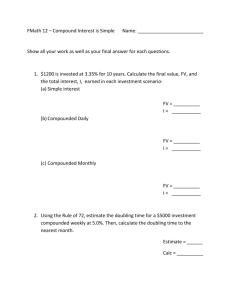MATH 141-501 Section 5.1 Lecture Notes Overview - Types of Interest
advertisement
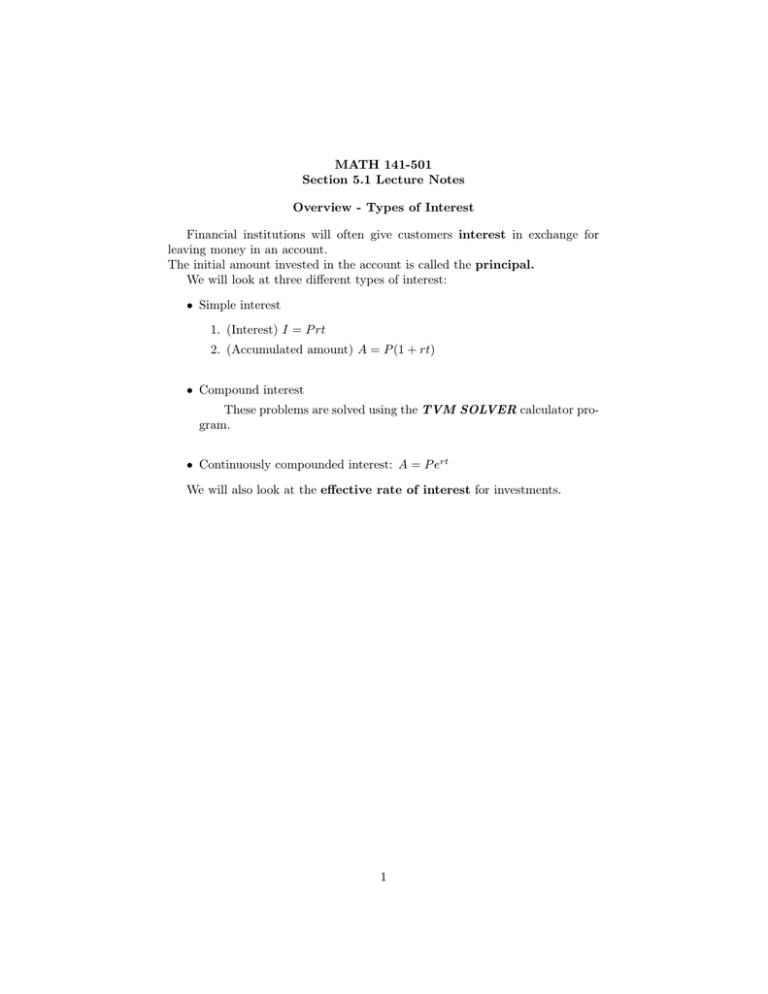
MATH 141-501 Section 5.1 Lecture Notes Overview - Types of Interest Financial institutions will often give customers interest in exchange for leaving money in an account. The initial amount invested in the account is called the principal. We will look at three different types of interest: • Simple interest 1. (Interest) I = P rt 2. (Accumulated amount) A = P (1 + rt) • Compound interest These problems are solved using the TVM SOLVER calculator program. • Continuously compounded interest: A = P ert We will also look at the effective rate of interest for investments. 1 Simple Interest Simple interest is interest which is only paid on the principal. Alice invests $5000 in an account which pays 5% simple interest annually. Assuming no withdrawals are made... • ...what is the interest payment after 1 year? • ...how much money is in the account after 1 year? • ...what is the interest payment at the end of year 2 ? • ...how much total simple interest has been paid after 2 years? • ...how much money is in the account after 2 years? • ...how much total simple interest has been paid after 3 years? • ...how much money is in the account at the end of 3 years? • ...what is the interest payment after year n? (n is a positive integer) • ...how much is money in the account at the end of n years? 2 Formulas for Simple Interest If a principal of P is invested in an account at an interest rate of r, then after t years, 1. the total simple interest is given by I = P rt. Interest = Principal x (interest rate) x time. 2. the accumulated amount is A=P +I Accumulated Amount = Principal + Interest A = P + P rt A = P (1 + rt)(this version of the formula is the one you usually see) Example 1 Find the accumulated amount at the end of 8 months on a $1000 bank deposit paying simple interest at a rate of 6% per year. Example 2 Mark made an investment of $3600 in an account paying simple interest. After 10 months, there was a total of $3748.50 in the account. Find the annual interest rate. 3 Compound Interest When an account pays compound interest, the interest is periodically added back to the prinicipal. After that, this interest itself earns interest. First, we look at the situation where interest is added back to the principal at periods of a certain length (annually, semi-annually, quarterly, monthly, weekly, daily, etc.) In these situations, the accumulated amount is also called the future value, and the initial amount (principal) is also called the present value. We will use the TVM SOLVER app in the TI-83/84 calculator for compound interest (and many other problems.) How to get TVM SOLVER: On TI-83: • Press [2nd] • Press [Finance] • Select [1: TVM Solver] On TI-83+ and TI-84: • Press [APPS] • Press [1: Finance] • Select [1: TVM Solver] 4 TVM SOLVER The TVM SOLVER is a screen which has the following variables: N - number of compounding periods I% - interest rate (as a percentage) PV - present value (initial investment) PMT - payment (not needed yet) FV - future value (accumulated amount) P/Y - payments per year C/Y - conversion periods per year PMT: whether payments are made at the beginning or end of the period (not needed yet) To use TVM SOLVER, 1. Put in relevant information that you know. 2. Move the cursor to the variable that you want to solve for. 3. Hit [ALPHA] [SOLVE]. Example: An investor puts $4000 in an account where interest is compounded monthly at a rate of 10% per year. Find the accumulated amount after 8 years. 1. Fill in relevant information that you know. N: I% PV PMT FV P/Y C/Y PMT 2. We want to find: 3. Solve. 5 Example: Alicia’s parents have just won the lottery. They want to set aside some of the prize for an educational fund to pay for Alicia’s college fund. If they estimate that they will need $110,000 in 8 years, how much should they set aside now if they can invest the money at 4% per year compounded... ...annually? ...semi-annually? N: I% PV PMT FV P/Y C/Y PMT 6 ...quarterly? Continuous Compounding Continuous Compound Interest Formula A = P ert P = Principal r = Nominal interest rate compounded continuously t = time (in years) A = accumulated amount at end of t years Example: If $4000 is invested in an account compounded continuously at a rate of 3%, find how much there will be in the account in 9 months. Example: You need $8000 in 2 years. Your financial advisor offers an investment which will pay continuously compounded interest at a nominal rate of 5%. How much do you need to invest now? 7 Effective Rate The effective rate of interest (also known as annual percentage yield) is the annual rate of interest that, if compounded annually, will yield the same accumulated amount as the nominal rate compounded m times per year (over the same length of time.) We can find it using the TVM SOLVER function called Eff . Calculator Syntax: Eff(I,m) gives the effective rate of interest corresponding to a rate of I% compounded m times per year. Example: Find the effective rate of interest corresponding to a nominal interest rate of 9% year compounded semiannually. Example: Find the effective rate of interest corresponding to a nominal interest rate of 5% per year compounded monthly. Example: For a one-year investment, a financial company offers you the option of a 10.5% interest rate compounded annually, or a 10% annual interest rate compounded quarterly. Which option should you take? 8
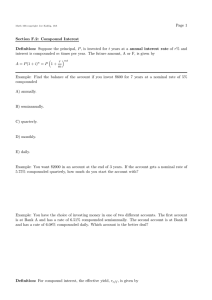
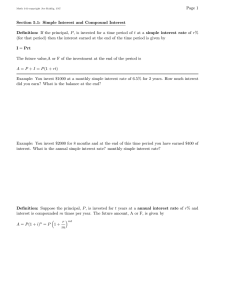
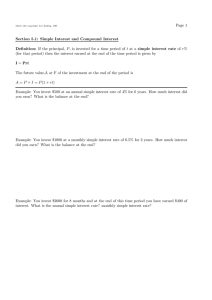
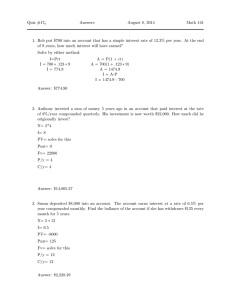
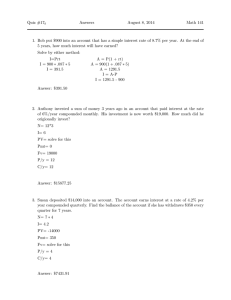
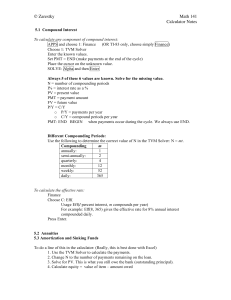
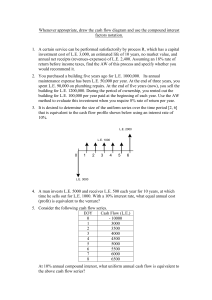
![Practice Quiz Compound Interest [with answers]](http://s3.studylib.net/store/data/008331665_1-e5f9ad7c540d78db3115f167e25be91a-300x300.png)
